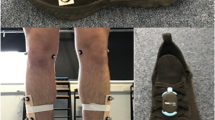Abstract
Since footwear flexibility impacts functional design factors, numerous studies have investigated footwear bending stiffness. However, the various methods used to measure footwear bending stiffness have some limitations. Hence, the scope of this study was to develop and quantify the reliability of a novel test set-up for measuring footwear bending stiffness. A test set-up consisting of a hydraulic testing machine, a bending apparatus and a fixation unit was created that fulfilled the requirements specified in the initial phase of the study. The test set-up was evaluated by testing 15 different boots in three series of measurements. Bending stiffness of the boots ranged from 0.61 ± 0.03 to 2.38 ± 0.08 Nm/°. Two-way analysis of variance test yielded that the test set-up enabled the reliable measurement of footwear bending stiffness. Relative measurement uncertainty ranged from 1.3 to 6.1 %.







Similar content being viewed by others
References
Nigg BM, Stefanyshyn DJ, Cole G, Boyer K (2005) Footwear research—past, present and future. In: Hamil J, Hardin E, Williams K (eds) Proceedings of the 7th Symposium on Footwear Biomechanics. ISB Technical Group on Footwear Biomechanics, Campus of Case, Cleveland, Ohio, USA. Case Western Reserve University Printing Services Cleveland, Cleveland
Reinschmidt C, Nigg BM (2000) Current issues in the design of running and court shoes. Sportverletz Sportschaden 14(3):72–81. doi:10.1055/s-2000-7866
Bojsen-Møller F (1982) Normale und pathologische Anatomie des Vorfusses. Orthopädie 11:148–153
Frederick EC (1987) Anforderungen an die Konstruktion von Laufschuhen. In: Segesser B, Pförringer W (eds) Der Schuh im Sport. Orthopädische und biomechanische Grundlagen zur Schuhversorgung des Sportlers. Fachbuch-Verlagsgesellschaft mbH, Erlangen, pp 31–39
Farkas R (1994) Der Test des Tests: Komplexe Analysen biomechanischer Laufschuhtests. Shaker, Aachen
Arndt A, Westbald P, Ekenman I, Lundberg A (2003) A comparison of external plantar loading and in vivo local metatarsal deformation wearing two different military boots. Gait Posture 18(2):20–26
Cikajlo I, Matjačić Z (2007) The influence of boot stiffness on gait kinematics and kinetics during stance phase. Ergonomics 50(12):2171–2182
Kleindienst FI, Michel KJ, Krabbe B (2005) Influence of midsole bending stiffness on the metatarsophalangeal joint based on kinematic and kinetic data during running. In: Hamil J, Hardin E, Williams K (eds) Proceedings of the 7th Symposium on Footwear Biomechanics. ISB Technical Group on Footwear Biomechanics, Campus of Case, Cleveland, Ohio, USA. Case Western Reserve University Printing Services Cleveland, Cleveland, pp 122–123
Park C, Choi W, Lee J (2007) Effects of hardness and thickness of polyurethane foam midsoles on bending properties of the footwear. Fibers Polymers 8(2):192–197
Shorten MR, Wright JC, Valiant G (1988) Effects of shoe flexibility on ground reaction forces and foot kinematics during fast walking. In: Groot G de, Hollander AP, van Ingen Schenua GJ (eds) Biomechanics. Proceedings of the 11th International Congress of Biomechanics. Human Kinetics, pp 710–714
Böhm H, Hösl M (2010) Effect of boot shaft stiffness on stability joint energy and muscular co-contraction during walking on uneven surface. J Biomech 43(13):2467–2472. doi:10.1016/j.jbiomech.2010.05.029
Requião LF, Nadeau S, Milot MH, Gravel D, Bourbonnais D, Gagnon D (2005) Quantification of level of effort at the plantarflexors and hip extensors and flexor muscles in healthy subjects walking at different cadences. J Electromyogr Kinesiol 15(4):393–405. doi:10.1016/j.jelekin.2004.12.004
Stefanyshyn DJ, Nigg BM (2000) Influence of midsole bending stiffness on joint energy and jump height performance. Med Sci Sports Exerc 32(2):471–476
Roy JR, Stefanyshyn DJ (2006) Shoe midsole longitudinal bending stiffness and running economy, joint energy, and EMG. Med Sci Sports Exerc 38(3):562–569. doi:10.1249/01.mss.0000193562.22001.e8
Toon D, Vinet A, Pain MTG, Caine MP (2011) A methodology to investigate the relationship between lower-limb dynamics and shoe stiffness using custom-built footwear. Proc Inst Mech Eng P J Sports Eng Tech 225(1):32–37. doi:10.1177/1754337110396792
Cavanagh PR, Hinrichs RN, Williams KR (1980) Testing procedure for the 1981 Runner’s World Shoe Survey. Runner’s World 10:38–49
Nigg BM, Stefanyshyn DJ, Nigg SR (1996) Biomechanical and material testing of sport shoes: adidas America research and innovation report. Human Performance Laboratory, University of Calgary, Calgary
ASTM International (1994) Test method for flexibility of running shoes. ASTM International, West Conshohocken, PA(F0911-85). doi:10.1520/F0911-85R94
Kleindienst FI (2003) Gradierung funktioneller Sportschuhparameter am Laufschuh in Bezug auf eine anthropometrische Differenzierung, geschlechtsspezifische Differenzierung und geographische Differenzierung. Shaker, Aachen
Jarboe NE, Quesada PM (2003) The effects of cycling shoe stiffness on forefoot pressure. Foot Ankle Int 24(10):784
Hillstrom H, Song J, Heilman B, Richards C (2005) A method for testing shoe torsional and toe break flexibilities. In: Hamil J, Hardin E, Williams K (eds) Proceedings of the 7th Symposium on Footwear Biomechanics. ISB Technical Group on Footwear Biomechanics, Campus of Case, Cleveland, Ohio, USA. Case Western Reserve University Printing Services Cleveland, Cleveland
Oleson M, Adler D, Goldsmith P (2005) A comparison of forefoot stiffness in running and running shoe bending stiffness. J Biomech 38(9):1886–1894
DIN Deutsches Institut für Normierung e.V. Fundamentals of metrology—part 3: evaluation of measurements of a single measure and measurement uncertainty, vol 17.020. Beuth Verlag, Berlin 17.020(DIN 1319-3: 1996-05)
Acknowledgments
The authors would like to thank Mr Steffen Weichold for granting us access to the data of the foot scans and Mr Justin Lange for realizing the biomechanical study. This study was funded by armasuisse (Federal Department of Defence, Civil Protection and Sport DDPS).
Conflict of interest
The authors declare that they have no conflicts of interest.
Author information
Authors and Affiliations
Corresponding author
Rights and permissions
About this article
Cite this article
Krumm, D., Schwanitz, S. & Odenwald, S. Development and reliability quantification of a novel test set-up for measuring footwear bending stiffness. Sports Eng 16, 13–19 (2013). https://doi.org/10.1007/s12283-012-0106-7
Published:
Issue Date:
DOI: https://doi.org/10.1007/s12283-012-0106-7




